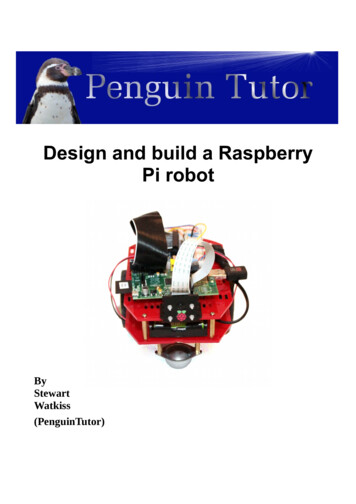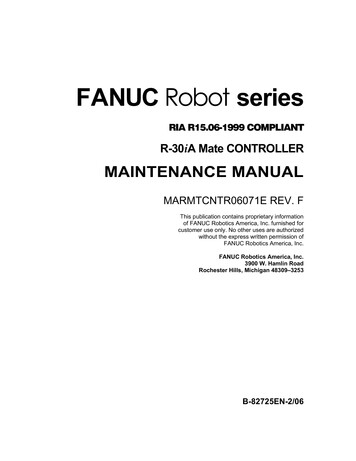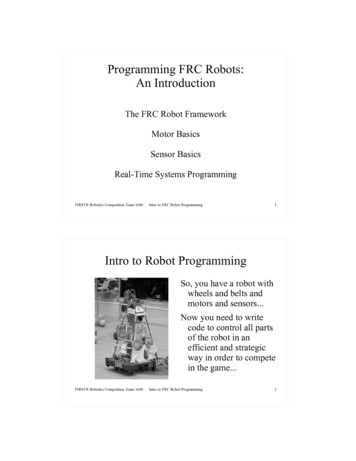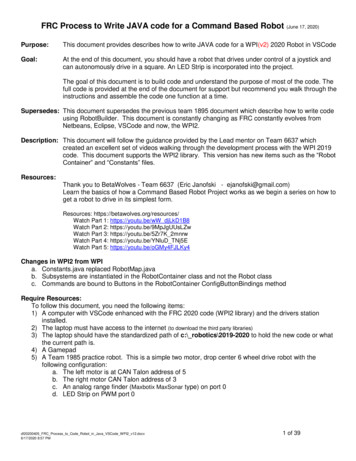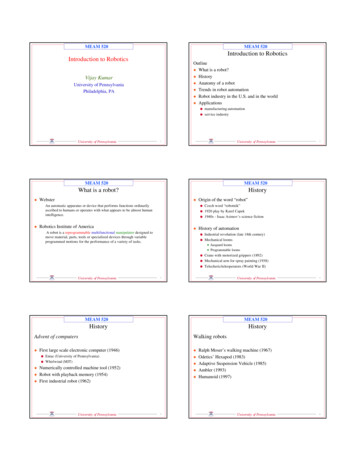
Transcription
About the AuthorKris Longmore is a self-taught systematic tradingexpert with a special interest in machine learning.Kris started blogging on RobotWealth.com tosolidify his learnings in algo trading as he went.Robot Wealth soon gathered a dedicatedfollowing and has developed into a community oflike-minded DIY traders interested in furtheringtheir trading through learning and applying thebest practices in algorithmic trading.Kris left his engineering career behind in 2016 toenter the world of finance full-time. He hasworked as a quant at a boutique hedge fund andnow runs his own consulting company advising finance companies on how machinelearning can transform their approach to the markets.Kris lives in Sydney, and enjoys long walks on the beach with his wife and exploringthe local rockpools with his two kids.www.RobotWealth.comBack to Basics: An Introduction to Algorithmic Trading3
CHAPTER 1:An Introduction to Algorithmic TradingAt its most basic level, algorithmic trading is simply the automated buying and sellingof financial instruments, like stocks, bonds and futures. It requires a networkedconnection to an electronic exchange, broker or counterparty, and a means ofprogrammatically buying, selling and performing other tasks related to trading, suchas monitoring price action and market exposure.Algorithmic trading is enabled thanks to the rise of electronic exchanges – a relativelyrecent phenomenon. Once upon a time, financial products were traded in the so-called‘pit’ inside the exchange building using the ‘open outcry’ method. This consisted ofbrokers and traders being physically present in the pit and shouting prices at whichthey were willing to buy and sell. Participants even used hand signals to convey theirintentions. This gradually began to give way to telephone trading and eventually toelectronic trading. The shift started sometime in the 1980s and continues to this day,however the vast majority of exchanges around the world are now electronic.Naturally, this evolution changed the dynamics of the trading process. Anecdotally, pittraders could sometimes read each other’s intentions through the physical contact thatcomes with being in the pit – obviously this is incredibly implausible when marketparticipants trade electronically and can be separated by potentially vast spaces.Stories of life in the pit makes for interesting and often amusing reading.Some curated links: The Chicago Business School compiled the reflections of a number of pittradersThis post makes for an interesting insight into life in the pitsAs do these ‘Tales of the Pit’ and this blog about pit tradingwww.RobotWealth.comBack to Basics: An Introduction to Algorithmic Trading4
Exchange-traded Markets vs Over-the-counter MarketsIt is also worth noting that algorithmic trading is not just for exchange-traded markets:over-the-counter (OTC) markets are also traded algorithmically. An OTC market is onewhere orders are not executed through a central exchange, but rather between twoparties. OTC algorithmic trading typically takes place via an Electronic CommunicationNetwork (ECN) or dark pool. The former is typically used by market makers todisseminate and match orders with their network of counterparties. The latter is morelike a private execution venue where liquidity is provided by the participants of the darkpool, away from the exchange.Pros and Cons of Algorithmic TradingAdvocates of electronic trading point out the attendant increased market efficiency andreduced opportunity for manipulation. Electronic trading is also typically less expensiveand with the advent of cheap Internet, is accessible to anyone with a decentconnection. This means that an individual can buy or sell a financial product from theirliving room.It must also be pointed out that as electronic trading has taken off, the instance of‘flash crashes’ – huge spikes in volatility over short periods of time – has alsoincreased. A case can be made that suggests that algorithms exacerbate such a crashbecause they act much faster than a human can intervene. But on the other hand,exchange operators are finding ways to handle this new environment in safer ways,for example electronic mechanisms to curb extreme volatility, order routing coordination between exchanges and re-thinking the role of market makers. Whether itis fair to blame flash crashes on electronic trading is a huge and sometimescontentious topic.Algorithmic Trading in a NutshellIn order to execute trades algorithmically, we use a computer program connected tothe exchange (either directly or via a broker) that executes our desired tradingbehavior on our behalf. Such a program or algorithm is simply a set of detailedinstructions that a computer understands. A trivial example might go something like:“read some price data, calculate its mean and standard deviation,then if the most recent value of the price data is above its averageand the standard deviation is less than some threshold, send abuy order to market.”That’s a trivial example and of course most trading algorithms are much morecomplex, but you get the idea.www.RobotWealth.comBack to Basics: An Introduction to Algorithmic Trading5
The simple algorithm described above had some of the common aspects of analgorithmic trading system: A method to acquire data (“read some price data”), noting that this in itself couldbe quite a complex standalone algorithm and requires connection to a sourceof market data, usually in real time.Some analysis of that data (“calculate its mean and standard deviation”).A means of checking if some condition has been fulfilled based on the previousanalysis (“if the most recent price is above its mean and the standard deviationis less than some threshold”).Execution of the trading logic, which again can be quite a complex standalonealgorithm requiring a means of communicating with a broker or exchange,managing that communication link and keeping track of orders and fills.Other common components of such systems include: Risk management modules, for example position sizing calculations, exposuretracking and adjustment, and tools to track a system’s performance andbehaviour.Portfolio management tools, which are somewhat related to the above.Data handling and storage.Post-trade reconciliation and analysis.www.RobotWealth.comBack to Basics: An Introduction to Algorithmic Trading6
Confusing TerminologyThe assumption behind the description of the algorithm above is that itspurpose is the implementation of a signal-based trading system whichessentially follows the fundamental logic of “if this happens, buy, and if thathappens, sell.” The term algorithmic trading can actually have a slightlydifferent nuance, particularly in an institutional setting, that it pays to be awareof. In this setting, algorithmic trading can refer to the automated splitting of alarge order to get the best execution possible. Such algorithms typically splitup a large order into smaller pieces and send the pieces to market in a waythat optimizes the overall cost of the transaction.Consider a large hedge fund that wants to hold a significant position in a stock,say a couple of percent of its market capitalization. Buying such an order inone transaction would have an impact on the price of that stock (dependingon its liquidity) that would be disadvantageous to the fund. Entering theposition gradually in line with the capacity of the stock to absorb the order oftenreduces the overall cost of the transaction, sometimes significantly.Many in the institutional space will refer to algorithmic trading as the type thatsplits up a big order. These same folks will typically refer to the signal-basedsystem as an automated trading system. In my experience, the terms arelargely used interchangeably, and it therefore pays to understand the contextwhen talking about algorithmic trading.I generally use the terms systematic, algorithmic and quantitative tradinginterchangeably to refer to strategic trading algorithms that look to profit frommarket anomalies, deviation from fair value, or some other statisticallyverifiable opportunity.Different Strokes for Different FolksThe type of algorithmic trading that most readers of Robot Wealth are interested in isthe kind that seeks to identify opportunities to profit by buying low and selling higher.This is the signal-based type of system mentioned above. Within this broad category,there are different subsets of trading algorithm. While there is no one acceptednomenclature for classifying algorithmic trading systems, they can generally bedescribed as follows.Technical AnalysisTechnical Analysis (TA) refers broadly to the analysis of patterns of price and volumeto predict future market movement. It is therefore based on the assumption that thereexist repeating patterns in the price action of a market. The TA toolkit consists of acollection of indicators (price/volume transformations) like the Relative Strength Indexwww.RobotWealth.comBack to Basics: An Introduction to Algorithmic Trading7
(RSI) and Moving Average Convergence Divergence (MACD). It also includes thesuite of trend lines, support and resistance lines, formations like ‘flag’ and ‘pennant’and patterns like ‘head and shoulders.’ There is even a catalog of candlestick patternslike ‘engulfing bear’ that allegedly portend the future direction of the market. On themore esoteric end of the spectrum, we have things like Elliot Wave Theory whichasserts that markets move in predictable ‘waves’.While some of the tools of TA are sometimes used in more scientifically rigorousquantitative trading (see below), opinion is divided on whether TA as an approach topredicting the market has any utility; indeed, there are published academic papers thatsupport both sides of this argument (see for example Lo, Mamaysky and Wang, 2000and Chan, Jagadeesh and Lakonishok, 1996).Quantitative TradingQuantitative trading means different things to different people. For some, it may besimply another name for TA-based trading. For me, the distinguishing feature ofquantitative trading is the removal of subjectivity (decisions are based on quantifiableinformation). This implies that quantitative trading is based on some sort ofmathematical or statistical model of market behavior.There are an infinite number of models for market behavior, however finding one thatis accurate enough to generate profits is no trivial endeavor. Sometimes, a tool fromthe TA world might be used in a quantitative model, hence the cross-over that Imentioned above. An example of a popular model is the cross-sectional momentumstrategy, which essentially boils down to buying winners and selling losers. Anotherpopular one is the mean-reversion strategy, which essentially equates to sellingwinners and buying losers.As we move along the complexity scale, we might encounter a cointegrating pairsmodel. In this model, we find a pair of securities that can be combined such thattogether they form a mean-reverting series. Such strategies are appealing becausethey can be engineered to keep the trader market neutral, or close to it, with the goalof minimizing market risk. Just be careful with the underlying assumptions of such astrategy – that is, that a past cointegrating relationship will continue into the future.We can also build quantitative models based on fundamental data. Fundamental datalike earnings announcements are just numbers, and we now have the tools toefficiently and automatically process the news releases and company filings fromwhich these numbers are taken.There is a subset of quantitative trading that is currently undergoing a huge upsurgein interest. I am of course referring to machine learning and artificial intelligence,which seems to have captured the imagination of both technologists and lay peoplearound the world. With good reason, I might add. At its most basic level, machinelearning is simply the derivation of insights from data using statistical models. As such,linear regression can be considered a low-level machine learning algorithm. Today wehave much more complex tools, such as artificial neural networks and deep learning,support vector machines and boosting algorithms. Such tools are already widely usedto support business decision-making and improve the performance of complexsystems. It seems a very natural and obvious step to apply these tools to the markets.www.RobotWealth.comBack to Basics: An Introduction to Algorithmic Trading8
The reality is that while such tools are incredibly powerful, it is difficult (but notimpossible) to use them to model the markets directly. Applying the ‘classic’ datascience approach generally doesn’t work too well on financial data, at least in myexperience. The more celebrated machine learning applications in finance seem to bearound efficiently extracting insights from large and complex non-market data sets,like libraries of satellite images, social media feeds and other proprietary and opendata sets. Entire books could be written about this topic, but if you are really interestedin machine learning, there is enormous scope to apply it to financial decision making– just don’t expect an easy ride.High Frequency TradingHigh Frequency Trading (HFT) is admittedly not something I have a lot of directexperience with, but I have worked with folks who are directly engaged in the activity.HFT by definition must be algorithmic since it occurs on the scale of microseconds –or less. No human could engage in HFT without the support of computers. While HFTis generally signal based – that is, something occurs to trigger a buy or sell signal –speed and latency are generally more important than the actual signal itself. Theimplication of this is that co-location of the algorithm either in the exchange or as closeas possible is a prerequisite, and code must be optimized for speed and usually writtenin a low level language like C . This results in barriers that are simply too high forDIY traders, and indeed for many trading firms. From my conversations with HFTtraders, it is something of an arms race, and an expensive one at that.Why Should You Care about Algorithmic Trading?The trend towards algorithmic trading, and automation more generally, has beenunderway in the institutional trading space for some time. For instance, Bloomberg(2016) recently reported that:“Hedge funds almost doubled their use of algorithmic trading inthe forex market last year executing 61% of their trades viaautomated computer systems.”This trend can be seen in other markets too. In 2006, 40% of all orders were enteredby algo traders at the London Stock Exchange, rising to 60% in 2007. In 2010, thatestimate stood at over 80% (thefinancer.com, 2010).So why this shift towards algorithmic trading?Most algo traders that I speak to say that they would never trade any other way,typically quoting similar reasons that relate to overcoming human limitations: Computers process enormous amounts of data in the blink of an eye, enablingthem to constantly scan dozens or hundreds of markets simultaneously fortrading opportunities. A human trader can’t keep up with that sort of workload. Computers are not prone to the same execution difficulties that humans face:calculation errors, time required to manually enter order details into a brokerplatform, “fat fingers” errors.www.RobotWealth.comBack to Basics: An Introduction to Algorithmic Trading9
Computers have no emotional attachment to a trade or a market. Either thereis a trade opportunity present or there isn’t. Computers can execute a system consistently and continuously. Contrast thiswith a human who is limited to a few hours chart time per day, suffers fromfatigue and needs to pursue a social life (not that I would ever advocate leavingan algorithm to run with no human oversight).What I also find interesting is that most algo traders that I know have an enormousrespect for successful manual or discretionary traders. That’s because anyone whohas made money through algo trading knows precisely how difficult it really is, evenwith all the advantages of algorithms and automated computation described above.These things are powerful tools for navigating the markets, and folks who can beat themarket without them deserve tremendous respect.Personally, in addition to the advantages listed above, I view algorithmic trading as ameans of allocating tasks to the resource most capable of performing them. Thisneeds more explanation:Reading the points above, you would get the impression that humans are becomingobsolete in the world of trading. Not true! Just as there are many tasks that algos arebetter suited for, likewise there are certain things that humans are simply brilliant at.We have the creativity to view the markets in novel ways and come up with new ideasfor trading systems. We can perform research and stay abreast of the macroeconomicenvironment in ways that a machine simply can’t (for now, at least).Using algos to trade the markets frees up the trader to pursue meaningful tasks thatmake use of their skill set. I don’t know about you, but I don’t get much joy out ofstaring at charts all day. Nor am I particularly good at distilling meaning from them. Mytime is better spent researching and overseeing than looking for and executing tradingopportunities.Another nice by-product that arises through algorithmic trading is an automatedresearch and development environment. If a trader writes an algorithm for executingtrades in the live market, it is possible to test the algorithm on historical or syntheticdata before taking it live. This provides crucial feedback about the algorithm’s pastperformance as well as insight into when, where and why it might fail. Such feedbackis difficult, if not impossible, to get with a manually traded or discretionary system.Obviously I am firmly in the algorithmic trading camp and have so far focused on theadvantages that a trader receives by taking this approach to the markets. Of course,there is another side to every story and this one is no different. Some of the drawbacksto algorithmic trading include: It requires certain skills which one either needs to acquire personally or rely onothers to provide. Programming is the obvious prerequisite, but it is also usefulto know about market microstructure and computer hardware, software andnetworking. The tools that become available through computational trading, likeoptimisation and machine learning, are incredibly powerful and require specificknowledge to use appropriately. Algo trading is actually very difficult andrequires skills from multiple disciplines.www.RobotWealth.comBack to Basics: An Introduction to Algorithmic Trading10
Algorithmic trading comes with certain infrastructure considerations, such asbackup power and network connectivity. This is less of a problem with the riseof affordable managed private servers and cloud-based services, but definitelyneeds to be considered. Hardware dependency – what happens if the server hosting the algorithm goesdown? A (perceived) lack of control over the behaviour of the algorithm. For some traders, the loss of discretion or ‘gut feel’ that comes with algorithmictrading is problematic.Set and Forget?I have also noticed from time to time a misconception that algorithmic trading systemscan be simply set up and then forgotten about. This is most definitely not the case!Managing an algorithmic trading system actually represents a significant amount ofwork and it takes a lot of oversight. Any system that trades at the intra-day frequencywould ideally be monitored in real time. Where this is not possible, my personalpreference is to have alerts sent to my phone when trades are entered or closed orwhen my system loses its connection to my brokerage account. Trades also need tobe reconciled, preferably on a daily basis. This is important to ensure that the systemis behaving as expected, as well as to monitor any deviations between simulated andactual performance. Bugs can and do creep into any computer program and a tradingalgorithm is no exception!www.RobotWealth.comBack to Basics: An Introduction to Algorithmic Trading11
CHAPTER 2:How to Succeed at Algorithmic TradingWhere to Start?There is a lot of information about algorithmic and quantitative trading in the publicdomain today. The type of person who is attracted to the field naturally wants tosynthesize as much of this information as possible when they are starting out. As aresult, newcomers can easily be overwhelmed with “analysis paralysis” and wind upspending a lot of their valuable spare time working on algorithmic trading withoutmaking much meaningful progress. This chapter aims to address that by sharing theway in which I would approach algorithmic trading as a beginner if I were just startingout now, but with the benefit of many years of hindsight.This chapter is somewhat tinged with personal experience, so please read it with theunderstanding that I am describing what works for me. I don’t claim to be a guru onpersonal or professional development, but I did manage to independently develop myalgorithmic trading skills to the point where I was able to leave my day job for a careerin the markets – so maybe I have some personal experiences and insight that mightbe beneficial.If you’re new to algorithmic trading, I hope Chapter 1 whet your appetite for finding outmore and maybe even convinced you that algorithmic trading is a sensible approachto the markets. In this chapter, we will go a little further and investigate the things thatwww.RobotWealth.comBack to Basics: An Introduction to Algorithmic Trading12
people who are just starting out should think about. In particular, I aim to provide youwith something of a roadmap for getting started and making progress as efficiently aspossible, whatever your goals might be, by sharing some of the practical things thatI’ve learned along the way. This chapter will cover: What to learn in order to succeed; How to learn it; and Important practical considerations.What to do in order to succeedActive doing is so much more important than passive learning.Learning the theoretical underpinnings is important – so start reading – but it is onlythe first step. To become proficient at algorithmic trading, you absolutely must put thetheory into practice. This is a theme that you will see repeated throughout this chapter;emphasizing the practical is my strongest message when it comes to succeeding inthis field.Having said that, in order to succeed in algorithmic trading, one typically needs to haveknowledge and skills that span a number of disciplines. This includes both technicaland soft skills. Individuals looking to set up their own algorithmic trading business willneed to be across many if not all of the topics described below; while if you are lookingto build or be a part of a team, you may not need to be personally across all of these,so long as they are covered by other team members. These skills are discussed insome detail below.Technical skillsThe technical skills that are needed for long-term successful algorithmic tradinginclude, as a minimum:1. Programming2. Statistics3. Risk managementThere are other skills I would really like to add to this list, but which go a little beyondwhat I would call “minimum requirements.” I’ll touch on these later. But first, let’s delveinto each of these three core skills.1.ProgrammingIf you can’t already program, start learning now. To do any serious algorithmic trading,you absolutely must be able to program, as it is this skill that enables efficient research.Forget “click and drag” type software programs that promise algorithmic tradingsuccess without the need to write code, and if any trading educator tells you that youdon’t need to code, turn around and run and don’t look back. Accept that coding skillswww.RobotWealth.comBack to Basics: An Introduction to Algorithmic Trading13
are prerequisite, and get to it. After a while, you’ll probably find that you actually like itanyway.It pays to become familiar with the syntax of a C-based language like C or Java (thelatter being much simpler to learn), but to also focus on the fundamentals of datastructures and algorithms at the same time. This will give you a very solid foundation,and while it can take a decade or longer to become an expert in C , I believe thatmost people can reach a decent level with six months of hard work. This sets you upfor what follows.It also pays to know at least one of the higher-level languages, like Python, R orMATLAB, as you will likely wind up doing the vast majority of your research anddevelopment in one of these languages. My personal preferences are R and Python. Python is fairly easy to learn and is fantastic for efficiently getting, processingand managing data from various sources. There are some very useful librarieswritten by generous and intelligent folks that make data analysis relativelypainless, and I find myself using Python more and more as a research tool. I also really like using R for research and analytics as it is underpinned by ahuge repository of useful libraries and functions. It was written with statisticalanalysis in mind, so it is a natural fit for the sort of work that algorithmic traderswill need to do. The syntax of R can be a little strange though, and to this day Ifind myself almost constantly on Stack Overflow when developing in R! Finally, I have also used MATLAB and its open source counterpart Octave, butI would almost never choose to use these languages for serious algo research.That’s more of a personal preference, and some folks will prefer MATLAB,particularly those who come from an engineering background as they may havebeen exposed to it during their work and studies.When you’re starting out, I don’t believe it matters greatly which of these high-levellanguages you choose. As time goes on, you will start to learn which tool is the mostapplicable for the task at hand, but there is a lot of cross-over in the capabilities ofthese languages so don’t get too hung up on your initial choice – just make a choiceand get started!www.RobotWealth.comBack to Basics: An Introduction to Algorithmic Trading14
Simulation environmentsOf course, the point of being able to program in this context is to enable the testingand implementation of algorithmic trading systems. It can therefore be of tremendousbenefit to have a quality simulation environment at your disposal. As with anymodelling task, accuracy, speed and flexibility are significant considerations. You canalways write your own simulation environment, and sometimes that will be the mostsensible thing to do, but often you can leverage the tools that others have built for thetask. This has the distinct advantage that it enables you to focus on doing actualresearch and development that relates directly to a trading strategy, rather thanspending a lot of time building the simulation environment itself. The downside is thatsometimes you don’t quite know exactly what is going on under the hood, and thereare times when using someone else’s tool will prevent you from pursuing a certainidea, depending on the limitations of the tool.A good simulation tool should have the following characteristics: Accuracy – the simulation of any real-world phenomenon inevitably suffers froma deficiency in accuracy. The trick is to ensure that the model is accurateenough for the task at hand. As statistician George Box once said, “all modelsare wrong, but some are useful.” Playing with useless models is a waste of time. Flexibility – ideally your simulation tool would not limit you or lock you in tocertain approaches. Speed – at times, speed can become a real issue, for example when performingtick-based simulations or running optimization routines. Active development – if unexpected issues arise, you need access to the sourcecode or to people who are responsible for it. If the tool is being activelydeveloped, you can be reasonably sure that help will be available if you needit.There are a number of options, but for the beginner there is probably none better thanthe Zorro platform, which combines accuracy, flexibility and speed with an extremelysimple C-based scripting language that makes an ideal introduction to programming.The platform is being constantly refined and updated, with improvements beingreleased roughly quarterly. Zorro may not look like much, but it packs a lot of powerinto its austere interface and is an excellent choice for beginners. I’ve also personallyseen Zorro used as a research and execution tool in more than one professionaltrading setting. Fundamentals of Algorithmic Trading makes heavy use of the Zorroplatform and includes detailed tutorials on getting started, aimed at the beginner.www.RobotWealth.comBack to Basics: An Introduction to Algorithmic Trading15
2.StatisticsIt would be extremely difficult to be a successful algorithmic trader without a goodworking knowledge of statistics. Statistics underpins almost everything we do, frommanaging risk to measuring performance and making decisions about allocating toparticular strategies. Importantly, you will also find that statistics will be the inspirationfor many of your ideas for trading algorithms. Here are some specific examples ofusing statistics in algorithmic trading to illustrate just how vital this skill is: Statistical tests can provide insight into what sort of underlying processdescribes a market at a particular time. This can then generate ideas for howbest to trade that market. Correlation of portfolio components can be used to manage risk (see importantnotes about this in the Risk Management section below). Regression analysis can help you test ideas relating to the various factors thatmay influence a market. Statistics can provide insight into whether a particular approach isoutperforming due to taking on higher risk, or if it exploits a genuine source ofalpha.Aside from these, the mos
www.RobotWealth.com Back to Basics: An Introduction to Algorithmic Trading 7 Different Strokes for Different Folks The type of algorithmic trading that most readers of Robot Wealth are interested in is the kind that seeks to identify opportunities to profit by buying low and selling higher.




